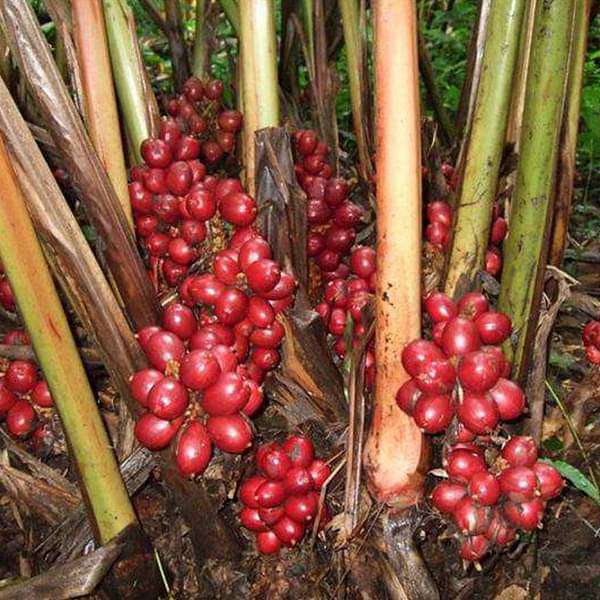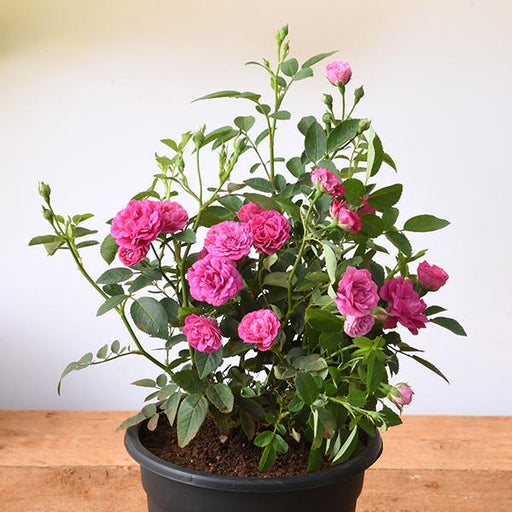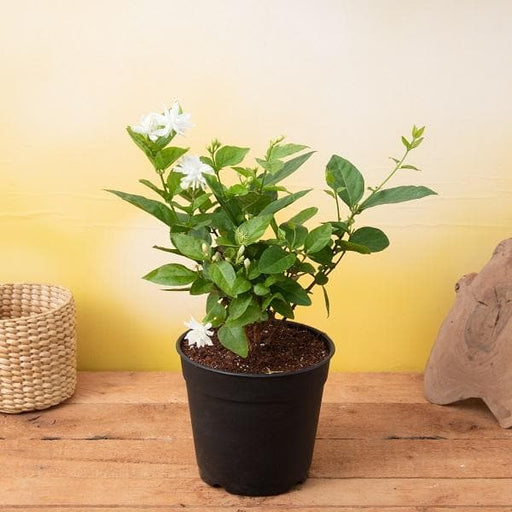
Badi Elaichi, Black Cardamom - Plant
(MRP Inclusive of all taxes)
- Shipping ₹79 for entire order
- Dispatch in 7 days
- Country of origin: India

(MRP Inclusive of all taxes)
 Save 29%
Save 29%
Air Purifier Money Plant with Pot The Air Purifier Money Plant, also known as Pothos or Epipremnum aureum, is a stunning indoor plant that...
View full details
 Save up to 15%
Save up to 15%
Peace Lily, Spathiphyllum - Plant The Peace Lily, scientifically known as Spathiphyllum, is a stunning houseplant celebrated for its elegant white...
View full details
 Save 25%
Save 25%
Jasminum sambac, Mogra, Arabian Jasmine - Plant Jasminum sambac, commonly known as Mogra or Arabian Jasmine, is a fragrant flowering plant...
View full details
 Save 18%
Save 18%
Combo Constituents Includes the Parijat Tree (Night-Flowering Jasmine), a culturally significant plant with fragrant flowers. Description The Pari...
View full details
 Save 25%
Save 25%
Miniature Rose, Button Rose (Any Color) - Plant The Miniature Rose, also known as the Button Rose, is a charming and compact flowering plant that ...
View full details Save 25%
Save 25%
Damascus Rose, Scented Rose (Any Color) - Plant The Damascus Rose, also known as Rosa damascena, is a timeless symbol of beauty and romanc...
View full details
 Save 17%
Save 17%
Beautiful Fragrant Mogra, Arabian Jasmine Plant with Pot The Beautiful Fragrant Mogra, also known as Arabian Jasmine (Jasminum sambac), is...
View full details Save 15%
Save 15%
Pack of Vermicompost and Neem Cake for House Plants Transform your indoor garden with our premium Pack of Vermicompost and Neem Cake, spec...
View full details
Pack of Plant Growth and Flower Boosters Unlock the full potential of your garden with our Pack of Plant Growth and Flower Boosters! This ...
View full details Save 38%
Save 38%
Combo of Jeevamrut and Neem Raksha for Easy Growth and Protection of Houseplants Transform your indoor garden with our exclusive combo of ...
View full details Save 22%
Save 22%
Plant Nutrients Kit (Pack of 16) for a Healthy Garden Transform your garden into a lush paradise with our Plant Nutrients Kit, featuring 1...
View full details Save 16%
Save 16%
Combo of Top Plant Fertilizers Elevate your gardening game with our exclusive Combo of Top Plant Fertilizers, featuring two bags of premiu...
View full details Save 24%
Save 24%
Pack of 4 Additives to Make Soil Healthy and Nutrient Rich Transform your garden into a thriving ecosystem with our Pack of 4 Additives de...
View full details Save 30%
Save 30%
Transform your gardening experience with our premium Combo of Perlite and Vermiculite. This unique blend is designed to enhance soil aeration and ...
View full details Save 27%
Save 27%
Combo of 2 Vermicompost and Cocopeat - Enrich Your Soil Naturally! Transform your garden into a thriving ecosystem with our Combo of 2 Ver...
View full details
 Save 35%
Save 35%
Best 6 Plants for Perfect Indoor Garden Transform your living space into a lush oasis with our curated collection of the Best 6 Plants for a...
View full details
 Save up to 50%
Save up to 50%
Mini Succulent Garden Pack Transform your space with our Mini Succulent Garden Pack, featuring a delightful collection of 4 any variety beautiful s...
View full details
 Save 30%
Save 30%
5 Best Fragrant Plants Transform your garden or indoor space into a fragrant paradise with our curated selection of the 5 Best Fragrant Plants. Th...
View full details
 Save 24%
Save 24%
Set of 2 Bonsai Looking Grafted Adeniums Transform your indoor or outdoor space with our exquisite Set of 2 Bonsai Looking Grafted Adenium...
View full details Save 45%
Save 45%
Top 4 Die Hard Succulents Pack Transform your indoor or outdoor space with our Top 4 Die Hard Succulents Pack, featuring a curated selecti...
View full details
 Save 30%
Save 30%
5 Best Indoor Plants Pack Transform your living space into a lush oasis with our '5 Best Indoor Plants Pack.' This carefully curated collection fe...
View full details
 Save 25%
Save 25%
Set of 4 Evergreen Air Purifier Plant Pack Transform your indoor space into a lush, green oasis with our Set of 4 Evergreen Air Purifier Pla...
View full details| SrNo | Item Name |
|---|---|
| 1 | Badi Elaichi, Black Cardamom - Plant |
Badi Elaichi, also known as Black Cardamom (Amomum subulatum), is a perennial herbaceous plant renowned for its aromatic pods that add a unique flavor to various dishes. Native to the Himalayan region, this spice is cherished not only for its culinary uses but also for its medicinal properties. The plant thrives in warm, humid climates, making it a perfect addition to your home garden or spice collection.
Black Cardamom is distinguished by its smoky flavor, which is achieved through a unique drying process over open flames. This spice has been used for centuries in traditional medicine, believed to aid digestion and respiratory health. Its rich history dates back to ancient trade routes, where it was valued as a luxury item, often referred to as the "Queen of Spices."
This plant not only enhances your culinary creations but also contributes positively to the environment. As a perennial plant, it helps in soil conservation and supports biodiversity. Additionally, its essential oils are known for their antimicrobial properties, making it a natural choice for health-conscious individuals.
Growing Badi Elaichi contributes to sustainable agriculture by promoting biodiversity and improving soil health. Its cultivation can help prevent soil erosion and support local ecosystems, making it an eco-friendly choice for gardeners and chefs alike.
Badi Elaichi, or black cardamom, is not just a spice; it’s a superhero in the culinary world! Packed with antioxidants, it fights off free radicals like a pro. It’s known to aid digestion, freshen breath, and even boost your mood. Who knew a spice could be your personal cheerleader? Sprinkle it in your dishes, and let the magic unfold. Your taste buds will thank you, and your body will be doing a happy dance!
Want to grow your own Badi Elaichi? It’s easier than you think! This tropical beauty loves warm, humid climates, so channel your inner gardener and create a mini jungle. Plant it in well-drained soil, give it some shade, and watch it thrive. Just remember, patience is key; good things come to those who wait, especially when it comes to spices!
Badi Elaichi is the secret ingredient that elevates your dishes from ordinary to extraordinary. Whether it’s biryani, curries, or even chai, this spice adds a smoky, earthy flavor that’s simply irresistible. It’s like the spice equivalent of a dramatic entrance at a party—everyone notices! So, don’t be shy; let Badi Elaichi steal the show in your kitchen.
Black cardamom is like that friend who always has your back. It’s known for its anti-inflammatory properties, helping to soothe those pesky aches and pains. Plus, it’s great for respiratory health, making it a go-to for clearing congestion. So, next time you’re feeling under the weather, consider brewing a cup of black cardamom tea. Your body will thank you, and you’ll feel like a million bucks!
In the world of traditional medicine, Badi Elaichi is a rock star. Used in Ayurvedic practices, it’s believed to balance the doshas and promote overall wellness. It’s like a natural remedy that’s been around for centuries, proving that sometimes, the old ways are the best ways. So, if you’re looking for a holistic approach to health, Badi Elaichi might just be your new best friend.
Harvesting Badi Elaichi is like a treasure hunt in your garden. Once the pods turn brown, it’s time to pick them! But beware, the process can be a bit tricky. You’ll need to dry them properly to preserve that delightful flavor. It’s a labor of love, but the reward is worth it. Freshly harvested black cardamom is a game-changer in the kitchen!
The battle of the cardamoms! While green cardamom is sweet and floral, Badi Elaichi brings a bold, smoky flavor to the table. They’re like the yin and yang of spices, each with its unique charm. So, depending on your dish, you can choose your fighter wisely. Why not have both in your spice rack? After all, variety is the spice of life!
In Indian cuisine, Badi Elaichi is a beloved staple. It’s the secret behind many rich, aromatic dishes that make your mouth water. From hearty curries to festive biryanis, this spice adds depth and character. It’s like the life of the party, bringing everyone together for a flavorful experience. So, if you want to impress your guests, don’t forget to include Badi Elaichi in your recipes!
Did you know Badi Elaichi has an essential oil? It’s like the cherry on top of the spice cake! This oil is known for its calming properties and can be used in aromatherapy to reduce stress. Just a few drops in a diffuser, and you’ll feel like you’re in a serene spice garden. Who knew relaxation could smell so good?
Badi Elaichi isn’t just for savory dishes; it can also work wonders in baking! Imagine the warm, spicy aroma wafting through your kitchen as you whip up a batch of cookies or cakes. It adds a unique twist that will have your friends asking for the secret ingredient. So, don’t be afraid to experiment; let Badi Elaichi take your baked goods to the next level!
To keep your Badi Elaichi fresh and flavorful, proper storage is key. Store it in an airtight container away from light and moisture, and it will stay potent for months. Think of it as giving your spice a cozy home. After all, nobody likes stale spices! Treat your Badi Elaichi right, and it will reward you with its delightful flavor every time you cook.
Badi Elaichi, or Black Cardamom, is the spice that brings the smoky flavor to your culinary adventures. Unlike its green cousin, it’s like the mysterious sibling who adds depth to your dishes, making them unforgettable. Think of it as the spice equivalent of a plot twist in your favorite novel!
Growing Badi Elaichi is like nurturing a diva; it craves warmth and humidity. Plant it in well-drained soil, give it some shade, and watch it flourish. Just remember, patience is key—this spice doesn’t rush to the party, but when it arrives, it steals the show!
Badi Elaichi is not just a pretty spice; it’s a health powerhouse! It aids digestion, freshens breath, and even has antioxidant properties. Think of it as your culinary superhero, swooping in to save your stomach and keep you feeling fabulous after that spicy feast!
Absolutely! Badi Elaichi adds a unique twist to desserts, transforming them from ordinary to extraordinary. Sprinkle it in your rice pudding or chai-flavored cake, and watch your guests wonder if you’ve secretly enrolled in a culinary school. Who knew dessert could be so adventurous
Badi Elaichi loves to mingle! It pairs beautifully with biryanis, curries, and even some stews. Think of it as the life of the party, enhancing flavors and making every dish a little more exciting. Just don’t forget to invite it to your next cooking session!
Store Badi Elaichi like a precious gem! Keep it in an airtight container, away from light and moisture. This spice doesn’t like to be exposed; it prefers a cozy, dark corner of your pantry. Treat it right, and it’ll reward you with flavor for months!
Not even close! Badi Elaichi and Green Cardamom are like siblings with different personalities. Badi Elaichi is bold and smoky, while Green Cardamom is sweet and floral. They both shine in their own right, but don’t expect them to swap roles anytime soon!
Oh, you bet! Badi Elaichi is a savory superstar. It adds depth to meats, lentils, and even vegetable dishes. Just a pinch can elevate your meal from “meh” to “wow!” So, don’t hesitate to let this spice strut its stuff in your savory creations.
Grinding Badi Elaichi is an art! Use a mortar and pestle for a rustic touch or a spice grinder for efficiency. Just remember, the fresher the grind, the better the flavor. It’s like giving your dishes a fresh haircut—everyone notices the difference!
Yes, indeed! Badi Elaichi can turn your regular cup of tea into a fragrant delight. Just toss in a pod while brewing, and let the magic happen. It’s like giving your tea a luxurious spa day—your taste buds will thank you!
When stored properly, Badi Elaichi can last for up to two years. It’s like that reliable friend who’s always there when you need them. Just keep it in a cool, dark place, and it’ll be ready to spice up your life whenever you call upon it!